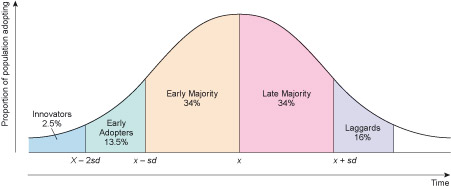8.8 Diffusion of innovations
The extent to which an invention becomes an innovation is largely a result of the way it spreads through a population of people or organisations. This process is known as the diffusion of innovation. Again, we briefly flagged this topic in Section 1 and the fact that the study of diffusion has been heavily influenced by Everett Rogers, whose book Diffusion of Innovations is in its fifth (2003) edition at the time of writing (2013). Rogers identifies four main elements in the diffusion of an innovation:
- The innovation. An innovation is any idea, object or practice that is new to the would-be adopter. There are five main characteristics of an innovation that influence its uptake:
- Relative advantage: the extent to which it is thought to be better than whatever it replaces.
- Compatibility: the extent to which it is thought to be compatible with adopters’ past experiences, values and other technologies. For example, the diffusion of contraception is heavily influenced by a community’s religious beliefs.
- Complexity; the extent to which potential users find an innovation easy to understand and use.
- Trialability: the extent to which a potential adopter can ‘try before they buy’ an innovation, and hence reduce the risk of adopting.
- Observability: potential users are more likely to adopt an innovation if the benefits of others’ use are more visible to them.
- Communication channels. Potential adopters generally find out about an innovation through personal communications and through the relevant media. The similarities and differences within people’s social networks play important roles in how people get to know about and understand innovations.
- Time. Decisions about the adoption of an innovation often change over time. For example, in a competitive situation the advantages of adoption of an innovation will often be greater for the earlier adopter. The competitive advantage of using a van to deliver produce to customers would be rather higher when competitors are still using a horse and cart. Once everybody is using a van, it becomes merely a cost of doing business and there is little or no competitive advantage to be gained.
- Social structure. Diffusion happens in social systems, and this will affect how an innovation diffuses. For example, in a bureaucratic organisation where decisions on procurement are made centrally, it will be harder for an individual to adopt an innovation without official sanction.
These factors will all affect the rate at which people adopt an innovation. However, there will generally be something like a ‘bell-curve’ of people adopting a technology. Rogers uses this curve to identify adopters as illustrated in Figure 11.

